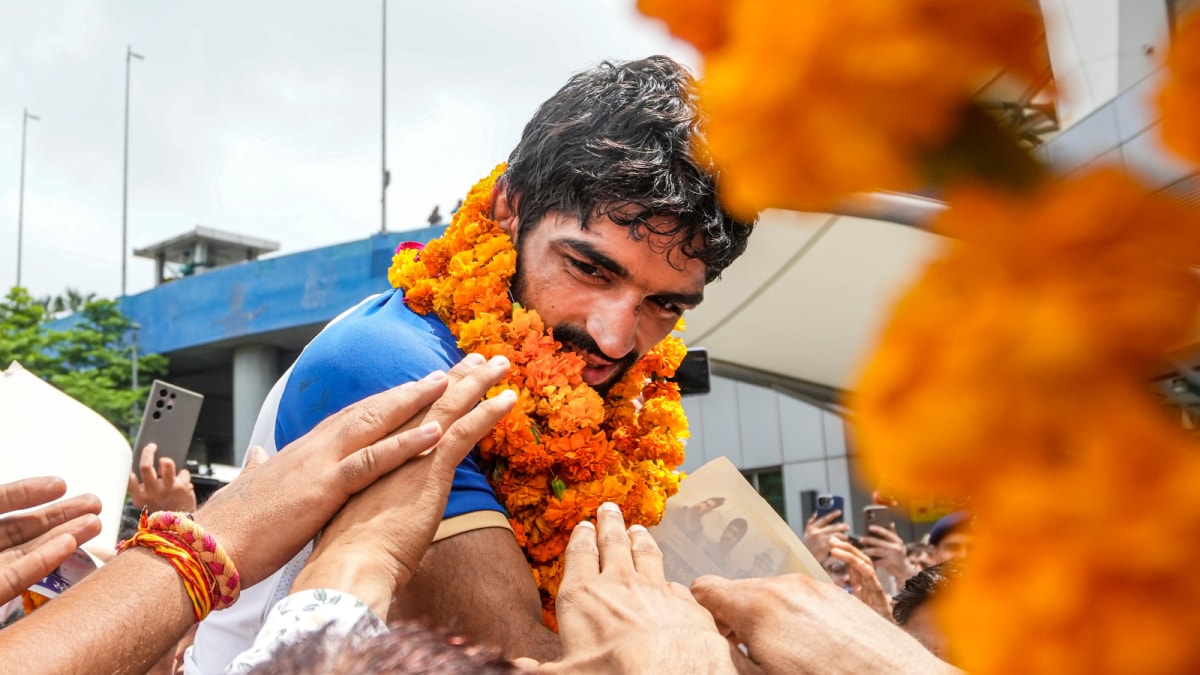 At this ICC Women's World Cup so far, India's No 4 and No 5 batters – Harmanpreet Kaur and Jemimah Rodrigues – have contributed a total of 136 runs in a combined 8 innings together. (AP)
At this ICC Women's World Cup so far, India's No 4 and No 5 batters – Harmanpreet Kaur and Jemimah Rodrigues – have contributed a total of 136 runs in a combined 8 innings together. (AP)
At this ICC Women’s World Cup so far, India’s No 4 and No 5 batters – Harmanpreet Kaur and Jemimah Rodrigues – have contributed a total of 136 runs in a combined 8 innings together, with an average of 17.00 and strike rate of 86.62, without a single fifty-plus score. These are simply not good enough numbers for a side harbouring hopes of pushing for the elusive global title, entering the tournament as one of the challengers for Australia’s crown.
Even a struggling New Zealand have better numbers for these two crucial positions in any batting order, especially in a tournament where middle and lower-middle order contributions have been match-defining. Sophie Devine, leading from the front in her final ODI World Cup, and Brooke Halliday have amassed a combined 402 runs in just three matches. On Monday in Visakhapatnam, Bangladesh too went past India’s numbers for these batting positions. India have been let down so far by two of their main batters, and while they were saved by contributions by lower down the order in the first two matches, the batting line-up being short of runs has played a critical part in the back-to-back defeats against South Africa and Australia. This has also meant that India have been risk-averse to drop a batter and playing an additional bowling option which would give them enough cushion with the ball, which has been lacking in both their defeats.
In the two years before this World Cup, India’s top four run-getters in women’s ODIs were Smriti Mandhana (far and ahead of the rest with 1,709 runs) followed by Jemimah, Pratika Rawal, and Harmanpreet. The four were expected to do the heavy lifting for India’s batting, their strong suit. While Mandhana and Rawal struck form against Australia, the other two are yet to come to the party.
At one point during the India vs Australia game on Sunday, there was a throwback moment to 2017. In the 35th over, bowled by Megan Schutt, Harmanpreet tapped the ball to the cover region and took off immediately for a quick single. She was halfway down the pitch but Harleen Deol at the non-striker’s end wasn’t keen on running. Harmanpreet had to hit the brakes, turn around, and put in a dive to ensure she wasn’t run out. She stood up and let Harleen have an earful. She was angry at the non-response and she made sure Harleen knew it. It was right out of the script that unfolded in Derby at the 2017 edition, when it was Deepti Sharma at the receiving end. Harmanpreet was batting on 98 at that time, was keen to run a double when Deepti was hesitant. The latter had to put in a full-stretch dive and it irked Harmanpreet immensely, as she threw her helmet down in anger and remonstrated with Deepti was the perceived lack of game awareness.
Story continues below this ad
That day, Harmanpreet went on to add 71 more to finish unbeaten on 171* in the semifinal against Australia. On Sunday in Visakhapatnam, immediately after letting out steam, Harmanpreet cleared her front foot and took out some of the frustration on the ball by smashing a four over mid-off. That was followed by another boundary next ball, a more measured late cut. It was only the start of her innings, but it felt like an angry Harmanpreet was channeling some of that Derby vibe. Alas, for India and her sake, it was only a brief flashback. For the fourth time in this World Cup, she looked to be in the mood after walking out to the middle but failed to convert another start. Her scores in this campaign read: 21, 19, 9, 22. For someone considered to be a big tournament player, the big score has proved elusive.
The manner of dismissals has been soft too. Against Sri Lanka, it was a late cut that was guided into the keeper’s gloves. Against Pakistan, she poked at one down the leg side to be caught behind again. In the next two matches, she was caught inside the ring on the offside. And the fact that she has walked out with a good intent to score but hasn’t converted the starts is an additional source of frustration.
For Jemimah, this World Cup was going to be a chance to make a statement. She was controversially left out of the previous edition, which led to a tough phase in her career before she bounced back and became one of the crucial cogs in this Indian batting wheel. In this tournament though, she has been out for two ducks so far, could have been out very early in another match, but was saved by a no-ball. Like Harmanpreet, her dismissals too have been largely due to unforced errors. As she pointed out in the press conference before the match against South Africa, the delivery she received in Guwahati from Sri Lanka’s Inoka Ranaweera was an absolute peach. But against Pakistan and South Africa, she was out LBW while playing her favourite sweep shot and completely missing the ball.
Only against Australia did she look to be in control, playing a little gem of a cameo in the backend for a 21-ball 33. But India needed more than a cameo against the world champions, and her dismissal played a part in India finishing on a below-par 330, which both coach Amol Muzumdar and captain Harmanpreet rued as being more than 20 runs short of where they should have finished.
Two defeats that leave the hosts in a precarious position to qualify for the semifinals, with matches coming up against a red-hot England and resurgent New Zealand next. Going ahead in the tournament, India need to win at least two of their remaining three matches and they’d need two of their star batters to come good.
.png)
.png) 7 hours ago
15
7 hours ago
15








 English (US) ·
English (US) ·